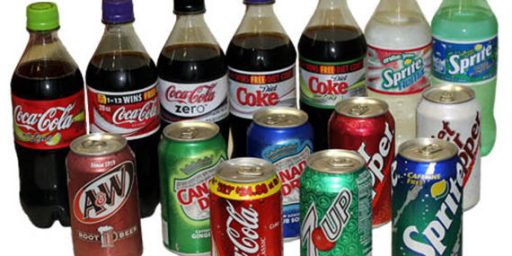Cola Economics
Daniel Gross explains why Coca-Cola’s next CEO is unlikely to replicate the growth levels of the past:
Coke’s next CEO will also apparently need the ability to overturn some basic economic rules. Once a national or global economy is sufficiently developed, exponential growth is impossible and even incremental growth becomes more difficult. The same argument applies to certain global brands like Coca-Cola, which has enjoyed exponential growth over its 118-year history. There is a limit to how much Coke the world’s population wants—or can afford—to consume. And from the looks of things, we’re bumping up right against it.
Of course, there’s population growth. And the fact that large sectors of the world’s population can’t afford expensive sugar water. Yet. Plus, I rather like the new Diet Coke with Lime.
Gross responds to some of this:
With U.S. Coca-Cola growth leveling off, future growth must come from the portions of the world where drinking Coke isn’t a daily habit. In its 2002 report, Coca-Cola noted that in Asia (population 3.3 billion), people consume about two servings of company products per month, while in Africa (population 831 million), average consumption is three servings per month. But the majority of the consumers in these untapped markets are living in relative poverty. They can’t afford to buy sugar and bottled water, much less pay a premium for a fizzy combination of the two substances. As a result, growth in these developing regions has been muted, too.
The economies of India and China are growing rapidly. But GDP per capita in those countries is just $500 and $1,200, respectively. And it will be several more years before huge chunks of the Indian and Chinese population have sufficient disposable income to spend on Diet Coke or Sprite. In the meantime, the business infrastructure that allows Coca-Cola to produce and distribute its products efficiently—and hence profitably—is sorely undeveloped in these massive potential markets. In 2003, according to Coca-Cola’s 10-K, sales in Africa and Asia rose 5 percent and 4 percent, respectively. For sales from these regions to make a significant contribution to Coca-Cola’s overall revenues, they’d have to rise at a pace several times greater.
A problem to be sure.
What if they made Coke also play MP3s and bundled it with Bacardi Rum, which they also own?
And, clearly, they’re not making full use of their brands in the U.S. For example, “Bimbo Break” would sell incredibly well over here. Indeed, just the Clinton and Kennedy families alone would make it worthwhile. And “Guarana Jesus” would certainly be a bestseller–especially with all the attention generated by the Mel Gibson movie.






Here’s a dream: Coke, in the interests of moving more product, accomplishes what no government so far has been able to do — builds a delivery infrastructure throughout Africa and Asia.
Hey, I’m all for a good distribution infrastructure.
Care to address the addictive component of high fructose corn syrup? And how that is addressed by current economic models?
Sugar water is addictive? My, my, my. The things you learn on the Internet.
“And the fact that large sectors of the world’s population can’t afford expensive sugar water. ”
Actually, not true.
Twenty years ago, I could buy Coke and Fanta in isolated African villages, Nicaraguan towns, and Andean tourist traps. All these areas had “unsafe” water, so drinking bottled sodapop was important…My adopted son’s Colombian village had no electricity and they slept on mats, but his uncle sold beer with a battery radio to supply music, and when he moved to the local city, they watched the “A team” and the intercity buses ran Charles Bronson movies to keep the customers happy…
And most of my traveling was done twenty years ago, so I suspect it is more common today.
You have no idea how globalization has impacted the most isolated area (remember the Far Sides cartoon of natives hiding the VCR’s at the cry “anthropologist, anthropologists”? It’s true…
our Filippino farm village got electricity 12 years ago, and now we see tv antennas and signs in houses: Cellphone calls available here, long distance to US, Saudi Arabia etc…(about a million Filippinos work in the Gulf states)…
Africa has gone backwards in some ways, but radios in remote villages and buying a Fanta Orange to refresh yourself on shopping day is a pleasure that outweighs other less needed things, such as clean water…true, in areas where refugees and starvation due to bad governments occur will not have such things, but let things stablize and you’ll see people “investing” in common pleasures once again…
Keep in mind, the rate of population growth has been steadily declining and most current estimates show world population growth stopping and possibly even beginning to decline by 2050.
Also the rate of world poverty continues to decline steadily, which it has been for decades.
Just thought I’d point that out. 😉
Tioedong, I’ve bought colas in the Third World, too. But, then, I came with an American wallet. The Philippines is relatively wealthy. I’d still wager that the average villager in Burkina Faso can’t afford a Coca-Cola.
Your point about the new brandlets is good, though: I only drink standard Coke on special occasions, and hate Diet Coke . . . but now that I’m thinking about losing weight, I’m giving the Diet Coke sub-genres a look: Cherry DC, Lemon DC, and Lime DC are all good low-cal alternatives to my beloved Hansen’s creme soda.
—